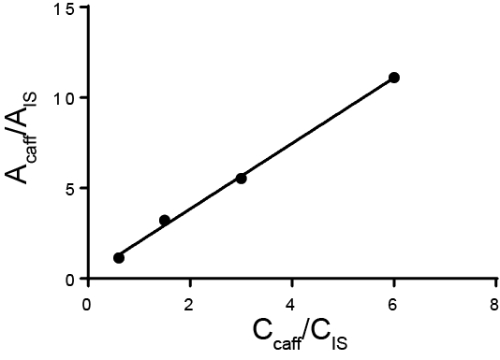Normas Internas
Visão Geral
Fonte: Laboratório da Dra.B. Jill Venton - Universidade da Virgínia
O objetivo de muitas análises químicas é uma análise quantitativa, onde a quantidade de uma substância em uma amostra é determinada. Para calcular com precisão a concentração de uma amostra desconhecida, a preparação cuidadosa da amostra é fundamental. Toda vez que uma amostra é manuseada ou transferida, parte da amostra pode ser perdida. Existem estratégias, porém, para minimizar a perda de amostras. Há também estratégias para lidar com a perda de amostras e ainda fazer medições precisas de concentração.
Para minimizar a perda de amostra, o ideal é minimizar o número de etapas de manuseio e transferência de amostras. Por exemplo, a massagem de uma amostra sólida diretamente em um frasco de que uma solução será feita reduz uma etapa de transferência. Se for necessário transferir de um frasco para outro e uma diluição estiver sendo feita, então enxaguar três 30 ções ajudam a garantir que toda a amostra seja transferida. Outras estratégias são mais específicas para a amostra. Por exemplo, amostras que adsorb para vidro, como proteínas, podem ser melhor manuseadas em tubos descartáveis de polipropileno. Os tubos não são hidrofílicos, por isso, se uma pequena quantidade de amostra deve ser cantada em água, é melhor já ter adicionado a água ao tubo, para que a amostra possa ser pipetada diretamente no solvente. Pode ser melhor concentrar-se, em vez de secar completamente uma amostra, devido a perdas de insolubilidades após a reidratação.
Outra fonte de perda amostral é através de manipulações amostrais incompletas. Por exemplo, se um procedimento de derivatização é usado e a derivatização está incompleta, então a quantidade total de amostra não é observada. Erros como esse são erros sistemáticos e podem ser resolvidos corrigindo o problema, como a alteração do procedimento de derivatização. Outra causa de erro sistemático nas medições são os efeitos matriciais. Estes podem interferir com a medição de certas substâncias e a realização de calibrações na mesma matriz que a amostra pode reduzir esse efeito.
A análise quantitativa é normalmente realizada utilizando-se normas externas ou internas. Para padrões externos, uma curva de calibração é feita medindo diferentes concentrações conhecidas do analito de interesse. Em seguida, a amostra é executada separadamente do padrão. Para as normas internas, a norma está na mesma amostra do analito de interesse, permitindo que a medida seja tomada simultaneamente. Tipicamente, uma espécie diferente é adicionada chamada padrão interno e a razão da resposta para esse padrão interno e o analito é calculado. A ideia é que a razão da resposta, chamada fator de resposta, seja proporcional à sua concentração. Embora o método deva ser capaz de distinguir entre o analito de interesse e o padrão interno, quaisquer perdas amostrais que ocorram após o padrão interno ser adicionado devem ser semelhantes para ambas as substâncias e, portanto, a razão da resposta permanece a mesma. Um caso especial de utilização de normas internas é o método de adições padrão, onde quantidades crescentes do analito são adicionadas à solução e a quantidade original de analito é calculada em segundo lugar. Padrões internos podem ser usados em cromatografia, eletroquímica e espectroscopia.
Procedimento
1. Manuseio adequado da amostra: Fazer uma solução
- Leve um béquer limpo e massa a quantidade correta de amostra nele. Grave a massa real usada. Neste exemplo, uma solução de adenina é feita em um frasco volumoso para uso como padrão interno para a próxima análise. A massa de adenina é de 100 mgs. Não entre diretamente em um frasco volumoso porque tem um pescoço longo e a adenina não pode ser facilmente adicionada ou removida.
- Adicione cerca de 25 mL de solvente (neste caso, sulfóxido de dimetil (DMSO)
Aplicação e Resumo
As normas internas são usadas em muitos campos, incluindo espectroscopia e cromatografia. Na espectroscopia, os padrões internos podem ajudar a corrigir erros aleatórios devido a alterações na intensidade da fonte de luz. Se uma lâmpada ou outra fonte de luz tiver potência variável, afetará a absorção e, consequentemente, a emissão de uma amostra. No entanto, a razão de um padrão interno para analito permanecerá constante, mesmo que a fonte de luz não o faça. Um exemplo disso é o uso de lítio (Li) como...
Tags
Pular para...
Vídeos desta coleção:

Now Playing
Normas Internas
Analytical Chemistry
205.2K Visualizações

Preparação da Amostra para Caracterização Analítica
Analytical Chemistry
85.1K Visualizações

Método de adição de padrão
Analytical Chemistry
320.5K Visualizações

Curvas de calibração
Analytical Chemistry
798.2K Visualizações

Espectroscopia ultravioleta-visível (UV-Vis)
Analytical Chemistry
624.7K Visualizações

Espectroscopia raman para análise química
Analytical Chemistry
51.4K Visualizações

Fluorescência de raios X (XRF)
Analytical Chemistry
25.8K Visualizações

Cromatografia gasosa (GC) com detecção por ionização em chama
Analytical Chemistry
282.7K Visualizações

Cromatografia Líquida de Alta Eficiência (HPLC)
Analytical Chemistry
385.5K Visualizações

Cromatografia de troca iônica
Analytical Chemistry
264.8K Visualizações

Eletroforese Capilar (CE)
Analytical Chemistry
94.2K Visualizações

Introdução à Espectrometria de Massa
Analytical Chemistry
112.6K Visualizações

Microscopia Eletrônica de Varredura (MEV)
Analytical Chemistry
87.3K Visualizações

Medições eletroquímicas de catalisadores suportados usando um potenciostato/galvanostato
Analytical Chemistry
51.7K Visualizações

Voltametria Cíclica (CV)
Analytical Chemistry
125.7K Visualizações
Copyright © 2025 MyJoVE Corporation. Todos os direitos reservados

